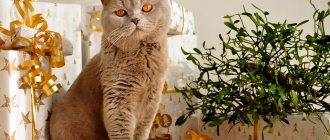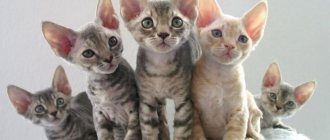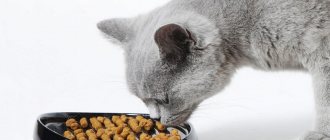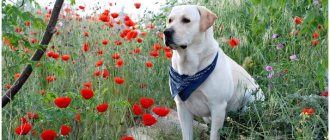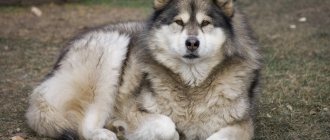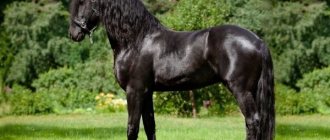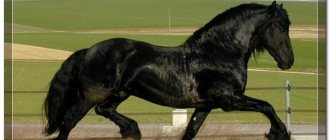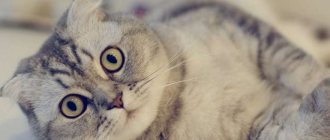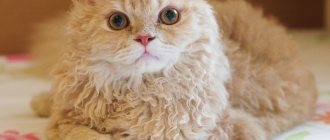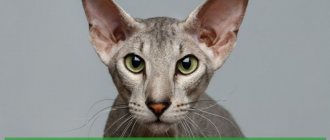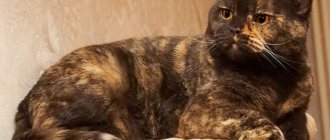Every person who has at least once been to exhibitions where British cats participated was surprised by the diversity of these animals.
And this is true, because the British have such a colossal range of palettes of their wool that some cannot count them. One of the colors that is included in this number is tabby.
Marble color
This color is that the color of the coat can be completely different, but there are patterns and certain elements on it.
Such elements may include:
- necklace (stripes around the neck);
- clear stripes around the tail and paws, slightly darker than the base color of the coat;
- richly colored hairs;
- on the forehead, a darker color than the main one, the letter “M” is clearly visible;
- the nose and eyes should be outlined with a clear outline of the color of the coat;
- the back wall of the ear has an imprint in a color slightly lighter than the main one.
According to established standards, the British tabby color can have only three types of pattern:
- marble (see photo of a marble Briton);
- spotted;
- brindle.
Brindle color
However, the interesting thing is that such basic elements can be present on a kitten of any color. They include: tortoiseshell, golden, smoky, silver, etc. Thanks to this diversity, the tabby color is impressive.
Let's look at these three main drawings in order.
Where does the British marbled cat come from?
Since the beginning of the 20th century.
British cats included not only plain blue animals, but also tabby cats with different shades on their fur coats. Thus, in 1901, American felinologists registered a Belle cat with a red tabby color. British marbled cats appeared as a result of crossing with other breeds
The consequence of two world wars was the almost complete extermination of the British breed, so breeders began to crossbreed pets with representatives of other varieties - Burmese, Russian Blues, Persians and Scottish. The result was the appearance of many varieties of British color while simultaneously preserving the breed characteristics (wide paws, protruding cheekbones, “plush” coat).
At the same time, among all the variations of the striped coat of the British fur coat, it is the marble color that is considered classic, occurring naturally. Zoologists are inclined to believe that the symmetrical darkening on the fur of catfish from Foggy Albion is an inheritance from wild Asian or African ancestors.
Origin story
British cats are not a native breed. They were brought to the islands by the Romans. Many years have passed since that moment, and modern Britons have acquired characteristics and traits that do not allow these cats to be considered separately from their habitats. Harsh Albion provided them with solidity and heavy bone, and felinologists perfected their magnificent exterior through outcrossing with the Persians.
The only thing that the British Shorthair has left for itself is its character. Majesty and the undeniable right to self-determination - this is briefly about the prototype of the Cheshire Cat. The standard comparison is nevertheless justified. Tenniel's drawings for the anthology of English surrealism are still used by breeders to this day.
The British Shorthair gave rise to more than one national breed: American, Scottish, European, Chartreux - all of them owe something to the British.
The official standard was registered back in 1898, and in the first half of the 20th century, the British, like many other European cat breeds, almost stopped their purebred lines due to wars.
The situation was saved by US felinologists who used the British to improve their native breed. Their nurseries compensated for the lack of cats to allow selection without attracting other breeds. Britons are still used in Scottish, European and American shorthair lines, but outcrossing of purebred cats within the breed is prohibited.
The British received the modern standard in 1982, and since then they have been recognized by all associations of felinologists.
BRITISH STRIPED COLOR (BRINCH, MACKERL)
The striped color of the British (British brindle tabby) must comply with all the same standards as the spotted one, only the pattern on the back and sides must have clear and uninterrupted stripes. In the color of a British Tabby Shorthair cat, the stripes should start at the spine and extend all the way to the paws. The stripes of a British brindle cat are narrow and frequent (and it is believed that the more often the better). Mackerel stripes (mackerel) should not intersect each other, be strictly vertical and always contrasting.
A brindle (striped) British kitten, even with very clear stripes, can “stretch” its color by adulthood and, if the stripes begin to be interrupted anywhere, the color is reviewed by experts and assigned - spotted. The full color of a British brindle kitten will be formed only by the age of one year (other tabby colors are not subject to such changes and most often do not change the appearance of the tabby pattern in adulthood).
British tabby cats are not as common as spotted cats, but more common than marbled cats.
The eye color of British tabby cats can be copper (golden, orange) or green (gold, occasionally silver).
Chocolate tabby British kitten: photo of California
Types of drawings
Tabby is not one specific pattern, as many people believe. There are several varieties of it, and all are considered standard. The pattern appears due to the A gene (agutti). A British female with the color formula “AA” gives birth to only patterned kittens, and with “Aa” the ratio of patterned kittens to plain ones is 50%. Cats with the formula “aa” will be monochromatic.
There are four main types of tabby patterns: ticked, striped, marbled, spotted.
Ticked (Abyssinian)
At first glance, it may seem that the British ticked coat is a solid color, but this is not the case. The color of their coat is not at all uniform: the whole body has barely noticeable stripes, spots or specks (there are “freckles”), slightly darker than the main tone of the British. The tip of the tail is usually dark. Eyes are golden or green.
Striped, brindle (mackerel)
The British tabby cat is the most popular cat available. The second name appeared due to the similarity with the color of the mackerel fish. The pattern is characterized by frequent narrow, clear stripes throughout the body, especially along the ridge. British tabbys are characterized by necklace-like lines on the chest and a broken stripe on the forehead, reminiscent of the Russian letter “M”. The British cat's full brindle coloration develops by the age of one year.
Classic (marble)
One of the most favorite colors among breeders of this breed is the marbled tabby. It is visible already from the birth of the kitten, it may merge slightly, but by two months it has a clear pattern. The body is covered with wide ornate patterns with clear outlines on the back, sides and vague ones on the abdomen and paws. The color of the pattern contrasts with the main shade of the Briton’s body – a kind of marble on silver.
Spotted (leopard)
A cat of the British breed with this coloring is similar to a representative of the wild - a leopard, but in miniature. Wide stripes are intermittent and represent spots of various sizes. Eye color: copper, green.
Tortoiseshells
Tortoiseshell cats are a favorite among breeders. From these mothers you can get a wide variety of offspring. Their unique color, also called torti, combines two groups of colors at once - red and black, and this is possible only in females. Tortoiseshell cats can only be born as a result of a genetic anomaly - mosaicism. Such animals are infertile and have the XXY genotype.
The tortoiseshell color consists of black and red spots evenly distributed throughout the body (or derivatives of these colors, for example, blue and cream, chocolate and cream, lilac and cream, etc.).
There are a huge number of British tortoiseshell species:
- Classic turtle (black-red, chocolate-red, lilac-cream, fawn-cream, cinnamon-red, lilac-cream).
- Smoky turtle (black and red smoky, chocolate red smoky, etc.).
- Tortoiseshell tabby, or torby (black and red tabby, chocolate red tabby, etc.).
- Tortoiseshell color point, or tortie (tortie point - black tortoiseshell, blue cream point - blue tortoiseshell, etc.).
- Bicolor tortoiseshells or calicos (black and red bicolor tortoiseshell, etc.).
- Bicolor tabby tortoiseshell, or torbico (marbled, striped, spotted bicolor tortoiseshell).
A tortoiseshell kitten can be born from parents of different color groups, for example, the mother is red and the father is black.
Where did this color come from and why is it called that?
The question of where cats of such bizarre colors and different breeds come from will certainly arise if a British kitten appears in the house. The tabby color was most likely inherited by domestic cats from their wild ancestors, the Nubian Dun. It is from this species of cat that all our short-haired pets originated.
As for the term “tabby” itself, there are several versions about its origin. The most beautiful sounds like this. Somewhere at the beginning of the 17th century, silk fabrics, which were worth their weight in gold, were first brought to England. Their pattern was very similar to a cat's color and was called "tabbis". And when they later began to breed cats with a similar color, they were called tabby. In addition, cats of this color, like silk, were very expensive, since breeding them is extremely difficult - it is difficult to obtain the necessary pattern, shade and eye color that matches them.
Health
The British Shorthair cat is not susceptible to hereditary diseases. She is in excellent health. However, this does not mean that vaccination and preventive examinations by a veterinarian can be neglected.
It must be taken into account that sexual and physical maturation in general occurs late in the British - around the age of four. It is at this age that kittens turn into adult cats: they show all the solidity and massiveness provided for by the standards. There is no point in sounding the alarm or suspecting dystrophy until this moment.
In comfortable conditions, a Briton lives on average 15 years. However, there are record holders in the breed whose age has exceeded 20. The reasons are simple: lack of stress, active cat life, balanced food and, of course, unconditional love. The well-being of the British largely depends on feeling like a member of the family.
Marbled Tabby
The marble tabby color in cats is the most beautiful, bright and complex. In addition, it is also the rarest due to difficulties in crossing - two marbled individuals can produce a tabby or spotted kitten. Such British cats wear three parallel stripes on the back, and large closed circles on the sides, inside of which there are brightly colored spots. Such a pattern should not intersect or be interrupted. In addition, a Marbled Briton must have the following markings:
- A pattern on the back of the head and shoulders resembling a butterfly.
- Patterns on the cheeks that start from the very corners of the eyes.
- "M" pattern on the forehead.
- The neck and chest are decorated with necklaces - the more, the better.
- There are spots on the tummy.
- The paws and tail must be ringed.
- The circles on the hips must be closed.
The color is rejected if the pattern is not contrasting enough, or if it shows residual faded stripes.
In a British cat, the merle color can be identified from birth. However, final alignment and clear drawing occur by two months. Therefore, if you want to get a real British harlequin, wait until this time, and do not adopt a kitten earlier.
Golden chinchilla
An even rarer, difficult to breed, but very beautiful, “sunny” variety of the British cat. Its color is so named because of its similarity to the fur of real chinchillas.
This cat wears a bright apricot-colored coat with black or blue “spraying.” The brighter the gold, the more valuable it is. Gray shades are not allowed. The nose and paw pads should match the base color. The eyes are necessarily green, except for the pointed subspecies. The colors differ in the degree of coloring of the hairs.
Golden shaded
Shaded is when only the upper third of the hairs are colored in the main color. In all other respects, the animal looks like it has a solid color, only slightly “dusted.” This effect is achieved due to the fact that each hair has a colored tip. The undercoat is peach or apricot.
Golden veiled
Veiling is when the top 1/8 of the hairs are colored. In all other respects, the animal looks the same as with a solid color, only in a barely visible transparent “veil”. This effect is achieved due to the fact that each hair has a colored tip. The undercoat is peach or apricot.
Required elements
The tabby color, despite many variations, has a number of unchanged elements:
- Ticking is actually the presence of the pattern itself. In this case, the hairs of the coat should be uniform in color down to the base.
- On the forehead of such cats there is always a pattern resembling the letter “M”, the so-called scarab sign.
- There should be a fingerprint-shaped spot on the back of the ear.
- The nose and eyes should be outlined. In this case, the color of the outline should be the same as the main color.
- The pattern, if there is one, must include the following elements: “necklace” - three closed stripes on the chest; “curls” on the cheeks; There are two rows of double spots on the tummy. All drawings should be clear and rich, and the coloring should be deep.
- There are also typical eye colors for tabbies - golden, orange and copper. If the color is silver, then the cat's eyes should be green.
If a Briton's color is blurred, and the patterns are cloudy and merge with the main color, then this is a defect. Most likely, one parent was a tabby and the other was a solid.
Ticked
Despite the fact that the ticked color belongs to the tabby cat colors, it has practically no pattern and looks like a solid color. The peculiarity is the brightness of the color of the main coat, and the upper part seems to be shaded. If you look closely, you will find that there are stripes on each hair. Of all the standard tabby color requirements, this color only has the letter "M" above the eyes and patterns on the face. If a ticked color has other main features of a tabby color, it will be rejected. This is a rather rare color subtype, because ticked males and females can produce kittens with any pattern on their coat.
BRI e 25 – cream ticked
BRI ny 25 – black gold ticked
Types of colors
Selection work on representatives of the British breed, involving various bloods, has led to a variety of both colors and breed types. If initially the British had short hair with a thick undercoat, then crossing with the Persian cat made it possible to obtain semi-long-haired animals. The colors of British longhair cats correspond to the colors of shorthair cats.
Many people only think of Britons as smoky, blue or tabby cats and don't even realize how many colors the breed has. Even a pair of quite ordinary parents can produce a kitten of a rare color.
To organize the variety of colors of British cats, they are divided into types and groups according to color, pattern and method of pigmentation.
Types of colors of British cats:
- solid (or plain);
- typed: smoky, veiled, shaded;
- gold;
- silver;
- tortoiseshells;
- color point;
- particolors: harlequin, bicolor, van, mitted;
- tabbies: spotted, striped, marbled, ticked.
A table of the colors of British cats will help you imagine all the diversity.
Recognizable appearance
The British cannot be confused with anyone else: a muzzle with a weakly defined “stop” and slightly rounded ears, huge eyes of a predominantly golden color and large cheeks that just want to be squeezed. And because of their plush fur, you don’t want to let go of them at all. Short-legged, with a massive body weighing on average 5-7 kg. The coat comes in both long and short hair.
British Shorthair
They have a short and thick six with a healthy shine. It feels elastic and soft to the touch.
British Longhairs
Six british longhair of medium length with thick undercoat. Feels more “plush” than British Shorthair cats.
striped british photo:
Possible tabby colors
Among tabby cats, gray and silver cats predominate with markings of a wide variety of colors: lilac, chocolate, blue, smoky black, reddish. But this does not mean that other tabby colors are rare. In the table below we look at the main variations of tabby color.
Table 2. Possible flower combinations for tabby color
| Color name | Marking color | Leading coat shade |
| Amber | Smoke black | Peach |
| Black silver | Deep black | Silver |
| Blue | Gray dust | Ivory |
| Blue silver | Grey | White |
| Bronze | Dark chocolate | Warm cream |
| Brown | Black night | Gray with brown or copper fade |
| Cameo | Fiery red | Warm ivory |
| Caramel | Milk chocolate with light color | Beige |
| Coal | Black chocolate | Smoke gray |
| Chestnut | Bright brown | Cream with possible orange undertone |
| Chocolate silver | Milk chocolate | Light blue silver |
| Cinnamon | Light chocolate with red flecks | Several shades lighter than the drawing |
| Golden cinnamon | Cinnamon | Ivory |
| Cream | Bright cream | Pale cream |
| Cream silver | Cream | Delicate silver |
| Faun | Light beige with cinnamon | Pale beige |
| Gold | Black | Milk chocolate with light color |
| Delicate amber | Grey, light gray | Tender peach |
| Lilac | Gray with splashes of pink or blue | Light cream |
| Peach | Brown with pink | Delicate cream |
| Red | Fire orange | Several tones softer than the original pattern |
| Purple silver | Lilac | Light silver with lilac splashes |
| Silver | Deep black | White |
It is worth noting that colors may vary depending on the design. Thus, spotted patterns are often presented in warm colors: golden, chocolate, wheat, brown, reddish, red. The classic type combines contrasting patterns of dark stripes on a light background: cream, yellowish, gray. The basis for dark striped patterns is silver and gray. The ticked type offers almost all possible colors. You can read about the mechanisms of genetic inheritance of pigments from cat to cat below.
Pigments and options for their transmission
In addition, the pattern may vary depending on the breed.
Table 3. Tabby color options for different breeds
| Breed | Color name | Marking color | Primary coat color |
| California speckled | Bronze, coal, snow leopard, royal glitter | Bronze - chocolate, charcoal - dark chocolate, snow leopard - black, glitter - brown with black | Bronze, snow leopard - ivory, coal - dark gray, glitter - gold |
| Egyptian Mau | Mottled Bronze, Smoke Spots, Mottled Tin | Bronze – chocolate, haze – dark chocolate, tin – gray-black | Bronze - cream, haze - dark gray, tin - silver |
| Ocicat | Golden cinnamon, sienna, spotted tawny | Cinnamon – chocolate, sienna – beige, tawny – dark chocolate | Cinnamon, sienna - ivory, tawny - red |
| Australian smoke | Golden haze, peach | Haze - golden chestnut, peach - brown with a hint of pink | Haze is several shades lighter, peach is a light cream |
| Bengal cat | Leopard, snow | Leopard - red markings in black circles, snow - cream markings in black circles | Leopard – yellow cream, snow – white |
Tabby cats with a rarer color are valued higher - because of this, they can cost more than their counterparts.
Silver chinchilla
It is still a rare, difficult to breed, but very beautiful, “royal” variety of the British cat. The color is so named because of its resemblance to the fur of real chinchillas.
The beauty is the owner of a snow-white fur coat with a “spraying” of the main color tone, black or blue. No yellow shades of wool are allowed. The nose and paw pads should match the base color. The eyes are necessarily green, except for the pointed subspecies. The colors differ in the degree of coloring of the hairs.
Silver shaded
Shaded is when only the upper third of the hairs are colored in the main color. In all other respects, the animal looks like it has a solid color, only slightly “dusted.” This effect is achieved due to the fact that each hair has a colored tip. The undercoat is white.
Silver veiled
Veiling is when the top 1/8 of the hairs are colored. In all other respects, the animal looks the same as with a solid color, only in a barely visible transparent “veil”. This effect is achieved due to the fact that each hair has a colored tip. The undercoat is white.
The main thing is love and affection
Cats of this breed are very sensitive and vulnerable. They definitely need to be petted, otherwise they get offended and worried. Simply feeding is clearly not enough. You need to take her in your arms and say kind words. They feel everything. Sometimes, even too much.
However, these cats will never impose themselves and get in the way
The owner himself must take the initiative and show attention to the pet.
Tabbies are very friendly and trusting. This breed is an excellent choice for families with small children. Cats will patiently endure any treatment from their little owners and will never show even a shadow of aggression towards them, not to mention extending their claws.
Representatives of this breed get along well with other pets. They can make excellent friends even with a pet rat, hamster or parrot, if there are any in the house.
Tabby (tabby) color of a British cat
The group of tabby (tabby) colors unites all cats that have a pattern in their color.
Presumably, the name “tabby” itself comes from the type of design (“tabbis”) on precious silk fabrics brought to England in the 17th century from the countries of East India.
Genetically, all cats (and male cats) are carriers of some kind of pattern - all are “tabbiks”, however, in the genetic makeup of cats there is a so-called “agouti” factor, which either allows the pattern to open - then it becomes visible, or does not allow it, then we see the animal has a solid color. A visual confirmation of this is the shadow pattern in small kittens of a solid color. Kittens “moiret”, stripes and spots are visible, which disappear with age. But, if the “agouti” factor allows the drawing to open up, the result is a “tabbik” - a patterned cat.
Color point
Color-point Britons have a light body color and dark markings on the face, ears, paws, and tail - points. This color is also called Himalayan or Siamese. The color of the points corresponds to one of the main colors, and the body color is in harmony with it.
Types of color point:
- solid;
- shaded;
- veiled;
- bicolor;
- smoky;
- turtle;
- tabby
Features of character and behavior
The British cat, massive and clumsy, is actually very, very active. It’s just that he prefers sleep to any active activity. The British sleep 20 hours a day, sometimes without stopping to eat.
Up to 3-4 years The British are not yet fully formed, both physically and psychologically. At this age, they are, in essence, still kittens with appropriate behavior - active and mischievous. Then the kitten becomes much calmer.
The breed is characterized by absolute self-sufficiency. The British Shorthair cat itself determines the rhythm of life, the time for affection and, especially, for games. Shows independence from early childhood. Even a small kitten has sacred knowledge of its rights. The most important thing is not to waste time. Kittens up to one year old are amenable to suggestion and education. After - no.
Soft and independent Britons have their own opinion about everyone. The kitten will choose a place to sleep himself. The owner’s task is to equip it. When dealing with a Briton, you must remember: he has remarkable intelligence and memory. Reviews indicate that from childhood the kitten demands respect for its person and really does not like noise.
You will have to forget about closed doors in the apartment: this will cause shock in an absolutely calm cat, even to the point of depression. Ideally, of course, the British should be able to roam freely. Then neither the cat nor the owner will experience any shocks.
The British Shorthair cat is non-aggressive, but will not allow itself to be offended. She is unobtrusive and rarely talks out loud about her feelings. If a Briton wants to eat, this will be expressed in a silent picket next to the cup.
Kittens get used to the family and are sincerely attached to the owner, but they can do quite well without his company.
Who is suitable for a British tabby?
If you consider the main qualities of a pet to be affection and the ability to cuddle it, then this breed is not for you.
British cats have an independent character and live “on their own.” They are not attached to any family member. They are not afraid of loneliness, and therefore are suitable for business people who stay at work for a long time.
The British do not require additional education. They are clean, and therefore the cat's litter box will have to be changed more often than usual: these clean people can ignore the dirty toilet and relieve themselves in another place. But in general they rarely bully.
Their coat does not require special care. Animals take care of their hygiene independently.
The British tabby dog will be a great friend for a child. However, he will not accept excessive affection from him: British cats do not like excessive attention to their person, and will not sit on your hands. Rarely shows aggression, and therefore can get along even with dogs. British kittens are very playful up to a year old, but with age they become lovers of lounging on the sofa.
Their motto in life becomes the phrase: “Once you’ve eaten, you can sleep.” If you sleep, you can eat.”
With such a lifestyle, it is important for the breeder to ensure that the pet does not gain excess weight.
Conclusion
A large selection of cat color palettes will suit everyone's tastes. Britons do not require much care and will make an excellent friend and pet.
https://youtube.com/watch?v=Eifs1WQ8EKQ%3F
How to choose the right kitten
It is better to buy a British dog from trusted breeders or in specialized nurseries that breed this particular breed. At the time of sale, the kitten must have a certificate confirming its origin and a veterinary passport with notes on vaccinations.
Little Britons should not show signs of aggression or fear. Cats should be active, playful and moderately curious. Healthy British babies have clear eyes, soft bellies, clean coats and smooth skin without scratching or redness.
Kitten care
Until the age of three months, little British babies live with their mother. By the time they move to a new home, kittens of this breed are already completely independent. They eat many foods, are accustomed to scratching posts and go to the litter box. Therefore, the owners can only show the pet where the bowls with food and the pot with filler are.
To make the little Briton comfortable, they provide him with a place to sleep. For safety reasons, wires, household chemicals, indoor plants, fragile and small things are hidden from the kitten.
